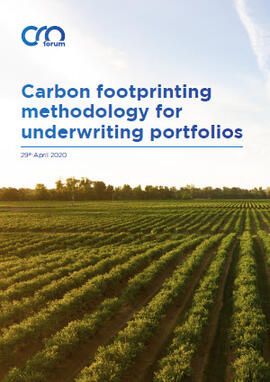- FR
- EN
Carbon footprinting methodology for underwriting portfolios
In its latest report, the CRO Forum analyzes the carbon footprinting of insurance companies’ underwriting portfolios.
May 4, 2020

As asset owners and asset managers support international efforts on carbon reduction in line with the 2015 Paris Climate Agreement’s target of limiting global warming to well below 2°C, and pursue efforts to limit it to 1.5°C, many have announced decarbonisation measures, such as reducing exposure to carbon-intensive sectors. To support these actions, carbon footprinting has seen increasing popularity in the financial sector over the last few years, as a method of measuring and disclosing carbon emissions – of both own operations and investment portfolios.
A PRI-Novethic assessment conducted in 2017 found that 59% of the asset owners and 55% of the asset managers surveyed used a carbon footprint of their portfolio1.
However, as these developments have broadly focused on investments, the opposite side of insurers’ balance sheets has received considerably less attention. Accordingly, carbon footprinting methodology quantifying the exposure of (re)insurers to carbon emissions from underwritten risks is currently underdeveloped, and the emissions associated with insurers’ core business remain unmeasured and undisclosed, even though it is possible to footprint where premiums are invested.
Despite the metric’s maturity for investment portfolios, caveats prevail, which are likely to also occur in the development of a carbon footprinting methodology for insurance liabilities. Current data challenges, affecting both the coverage and quality of existing data, still hinder a comprehensive uptake. Moreover, because a carbon footprint is a snapshot in time and not dynamic enough a measurement to analyse transition dynamics among economic players, or the potential of avoided emissions, it may be misleading to disclose carbon footprint alone – it should be accompanied by contextual, forward-looking information.
The new CRO report ‘Carbon footprinting methodology for underwriting portfolios’ summarizes a range of options, methodologies and barriers for the carbon footprinting of insurance companies’ underwriting portfolios. This will help insurers to work towards understanding the challenges and eventually disclosing the carbon intensity of their underwriting portfolios.
About the CRO Forum
The CRO Forum focuses on developing and promoting industry best practices in risk management. Comprised of Chief Risk Officers from multinational (re)insurance companies, it aims to represent the members' views on key risk management topics, including emerging risks. It regularly publishes practice and position papers on timely risk management subjects.
Frieder Knüpling, Group Chief Risk Officer of SCOR, currently serves as Chair of the CRO Forum.
1 PRI & Novethic, September 2017, Investor Action on Climate Change, https://www.unpri.org/download?ac=1871 .
